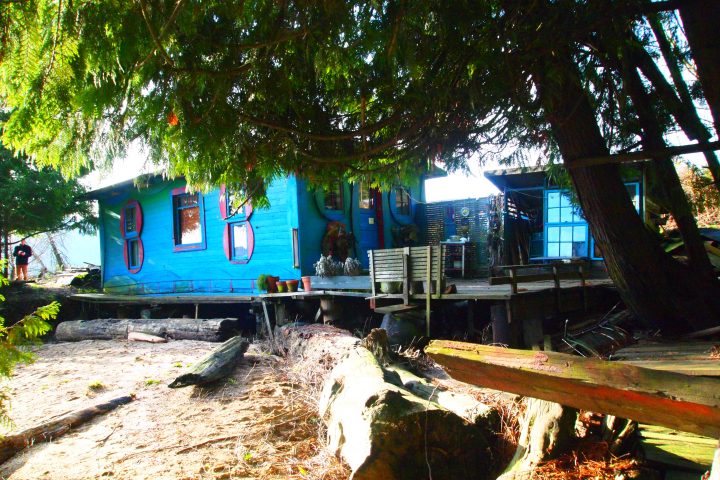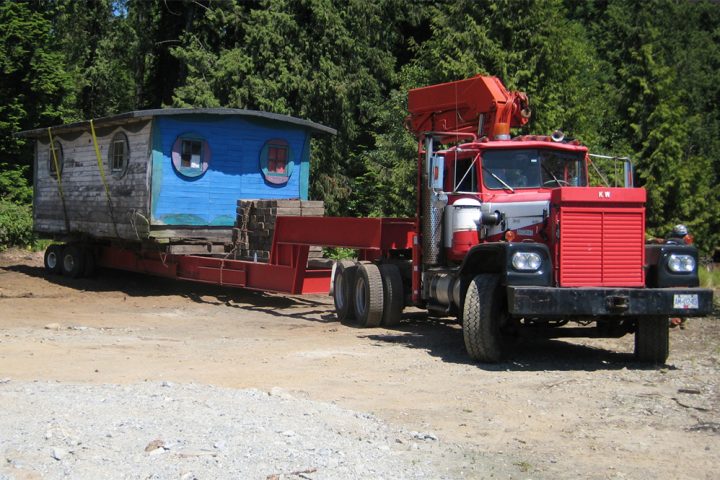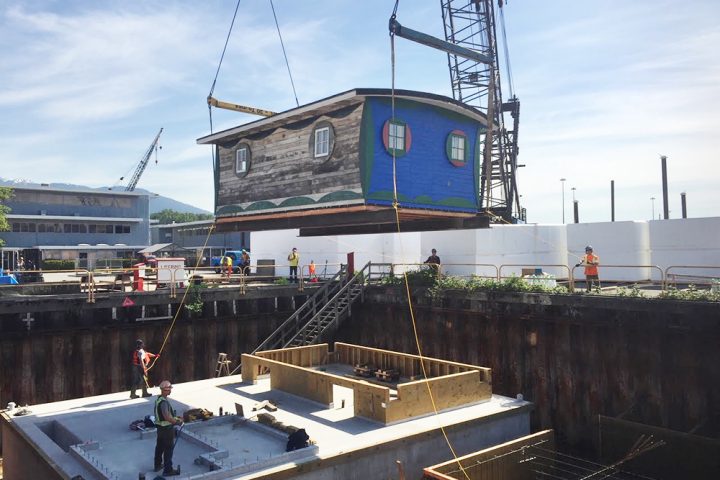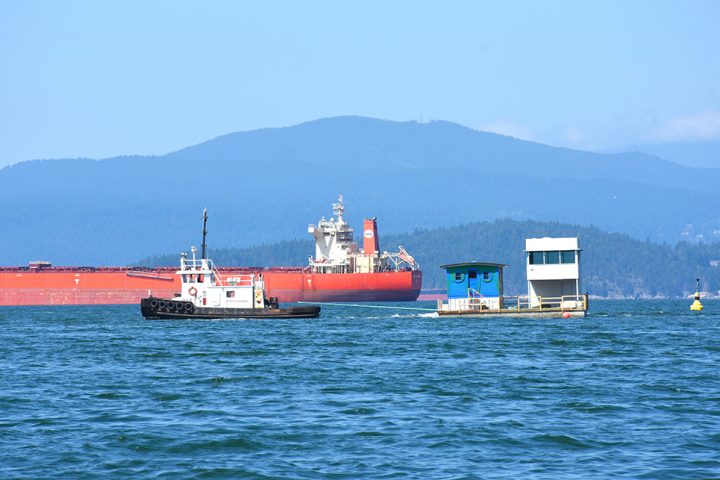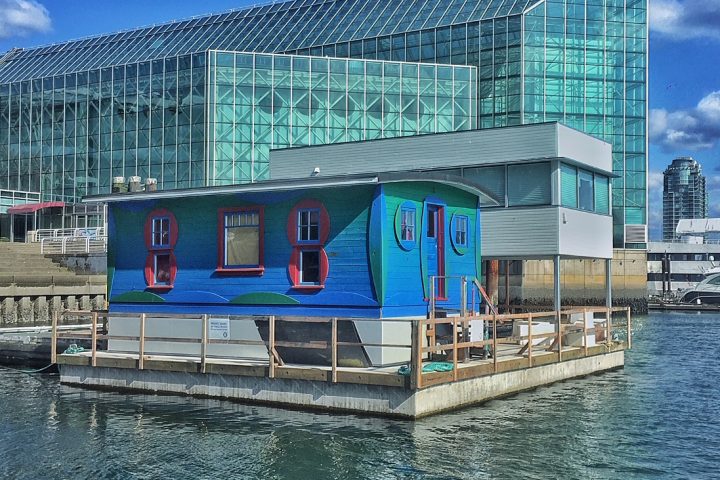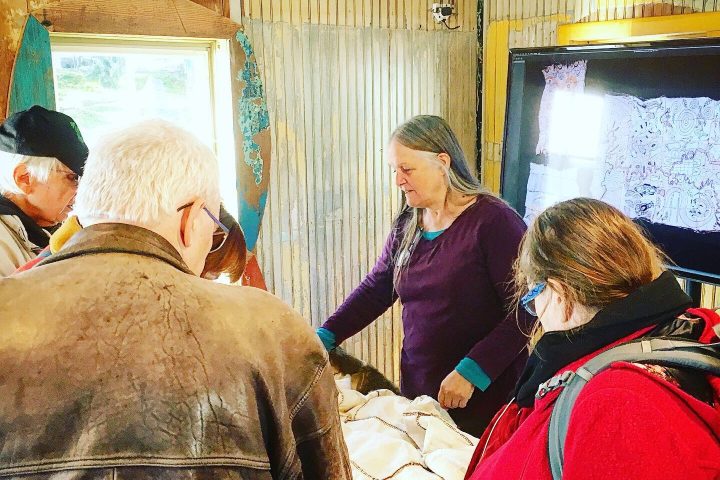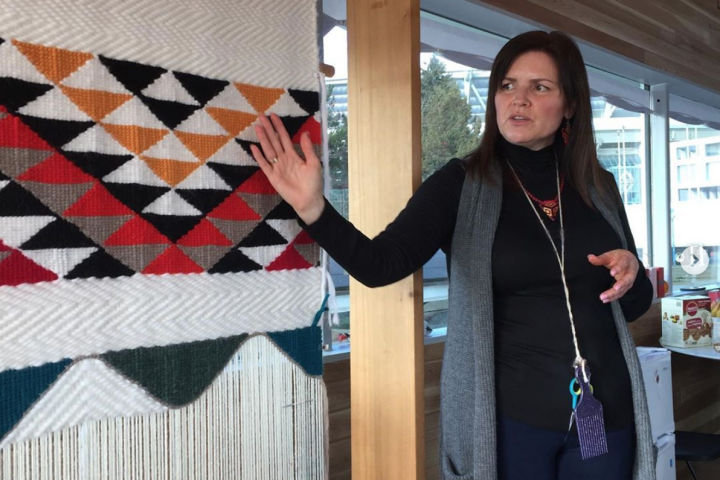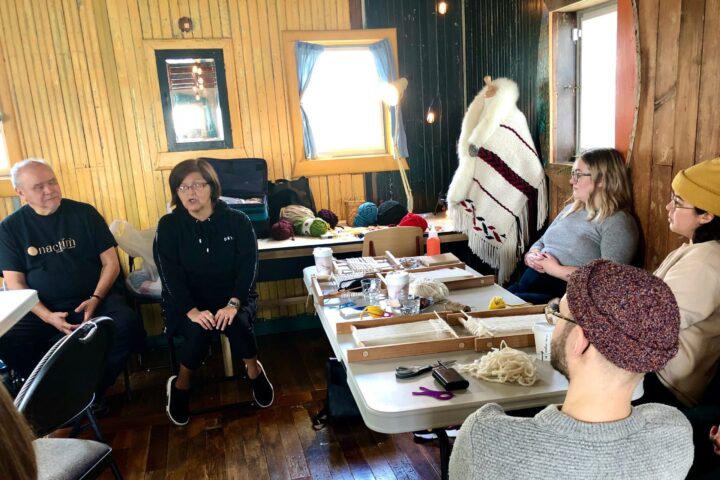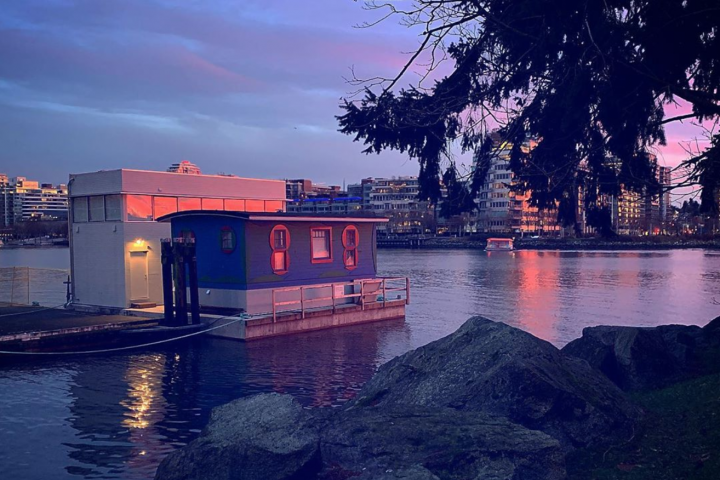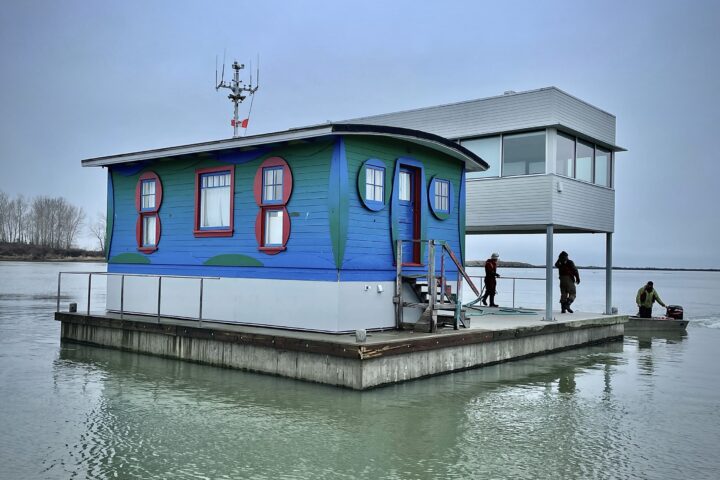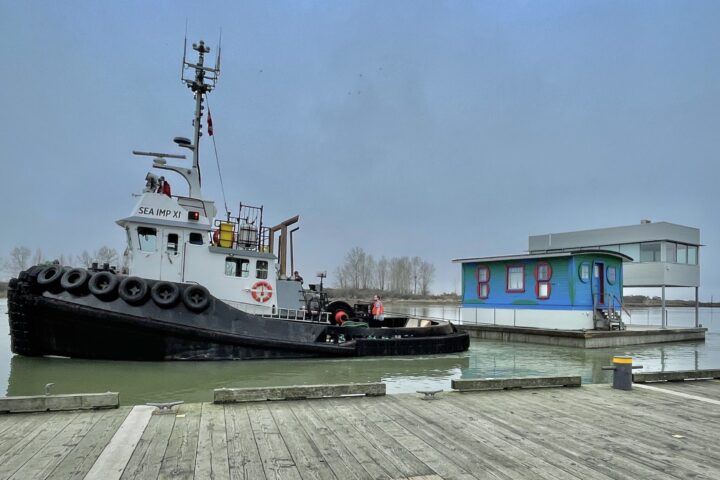BLUE CABIN
BLUE CABIN FLOATING ARTIST RESIDENCY
A partnership between Other Sights, grunt gallery and Creative Cultural Collaborations (C3).
Steering Committee: Lorna Brown (Other Sights), Vanessa Kwan (grunt gallery), Esther Rausenberg (C3)
Project Founders: Barbara Cole & Marko Simcic (Other Sights), Glenn Alteen (grunt gallery), Esther Rausenberg (C3)
2015-ongoing
Blue Cabin on Instagram Twitter & Facebook
Sign up to the Blue Cabin Newsletter
HISTORY
The Blue Cabin is a dwelling that has resisted ownership for more than 80 years. From 1932 to 2015, it rested on pilings above the intertidal zone of high and low tides on Tsleil-Waututh territory within the District of North Vancouver, Canada. The cabin was originally barged over from Coal Harbour to serve as a convenient place to live while the Norwegian carpenter who built it worked at the neighbouring shipbuilding yard. Tucked into a small cove between Cates Park and McKenzie Barge & Derrick Co., Ltd., it had been standing empty for a number of years before musician, artist and writer, the late Al Neil, moved there in 1966. At first he was a paying tenant, but later Neil acted as unofficial beach watchman in exchange for free rent. His partner, artist Carole Itter, joined him in the late ‘70s and both used this very special site as a generative place for art production until their eviction in 2015.
As characterized by heritage specialist and architectural historian Harold Kalman, “The Blue Cabin is the unique survivor of a once popular, but now vanished way of life, when people of little means could live ‘off the grid’ in ‘squats’ along the waterfront, yet be within an urbanized, metropolitan area. Many of the squatters in the Dollarton area were artists and the area formed a vital artists’ community.”
The McKenzie Barge site was sold to Polygon Homes for redevelopment in 2014, and under their agreement with Port Metro Vancouver, the developer was obligated to remediate the neighbouring contaminated foreshores, including the small bay the cabin was nestled within.
“The forced eviction of Al and Carole, the removal of the Blue Cabin, and the development of Cates Landing are representative of the ongoing gentrification of the shores of Burrard Inlet,” writes Kalman. Gentrification often leads to the loss of histories – in this case, the region’s foreshore histories, namely, maritime labour, immigrant, squatter, and Indigenous, as well as the history of cultural production that took place in the area by artists such as Tom Burrows, writer Malcolm Lowry, and of course Al Neil and Carole Itter.
FLOATING ARTIST RESIDENCY
In 2015, grunt gallery, along with Other Sights for Artists (Other Sights) and Creative Cultural Collaborations (C3), led efforts to move the cabin to a secure storage lot for repair and remediation, and began to develop a concept for an engagement site for the Blue Cabin. The lack of adequate spaces for extended-stay artist residencies in Vancouver has long been a concern due to continuously rising real estate prices. In view of this, and the cabin’s history on the foreshore, the idea to repurpose it as an off-the-grid floating artist residency on the Lower Mainland waterfront emerged as the chosen course of action: the Blue Cabin project will be a cost-effective means to accommodate an urban artist residency program, with the cabin functioning as a dedicated artist studio alongside an energy efficient tiny house where resident artists will live. Both structures will be sited on a floating platform that will move from time to time to different locations along the region’s waterways.
PUBLIC BENEFIT
The Blue Cabin project is committed to ensuring the cabin’s legacy continues, benefitting both artists and broader publics alike. The artist residency will provide a unique space for regional, national, and international contemporary artists to research and make work, engage with the local arts community, create dialogue with artists outside the Vancouver region, and expand audiences for contemporary art. More than a residency, the cabin will also act as a conduit for Vancouver’s lost histories, offering programming that would educate the public about the region’s foreshore history and the communities connected to it.
The mix of heritage and contemporary culture in this project creates a rare interface, one that presents opportunities to examine and celebrate where these concepts meet, and how they interact. Artists Neil and Itter have each greatly contributed to the cabin’s heritage value and cultural significance, and we believe future resident artists will use the Blue Cabin as a site to imagine new and exciting ideas, and create inspired projects that continue and expand upon that legacy.
REMEDIATION AND RESIDENCY BUILD
In moving forward with this plan for the Blue Cabin artist residency, the three founding organizations consulted with civic leaders, the Tsleil-Waututh Nation, businesses, cultural and heritage organizations, and community groups. In June 2017, the cabin was relocated from its storage site to a sheep pasture at Maplewood Farm in North Vancouver, where it underwent a full remediation by Mayne Island artists Jeremy and Sus Borsos. The restoration was completed in February 2018. grunt gallery archivist and Blue Cabin committee member Dan Pon talks about the Borsos’ restoration as, “at once a process of (re)construction, heritage preservation, and cultural archaeology, all undertaken with a profound regard for materials, technique, and provenance.” In 2018, the Blue Cabin received a Change Maker Award from BC Museums Association’s Roundup Magazine, and it was nominated for a BCMA Innovation Award. This allowed for the engineering and build of the concrete float platform and the design and construction of a state-of-the-art, ecologically sustainable deckhouse house.
RESIDENCY LAUNCH & ONGOING PROGRAMMING
The Blue Cabin Floating Artist Residency (BCFAR) launch occurred in August of 2019 at the Plaza of Nations Dock in False Creek, Vancouver. For the inaugural programming year Skeins: Weaving on the Foreshore celebrated Coast Salish weaving practices that have developed in these territories since time immemorial. It was anchored by the participation of weavers from the three local Host nations: Angela George from Sḵwx̱wú7mesh / səlil̓ilw̓ətaʔɬ, Janice George and Buddy Joseph of Sḵwx̱wú7mesh, and Debra Sparrow from xʷməθkʷəy̓əm. Skeins also included an international residency with Australian Indigenous artist and activist Vicki Couzens from Gunditjmara. Rooted in the local, and spanning the international, these artists are connected to a long history of cultural, ceremonial and community involvement, organizing, reclaiming, aesthetics and activism. Skeins program pdf.
Programming at the Blue Cabin was altered in early 2020 due to the global Covid Pandemic, Janice George and Buddy Joseph completed their residencies, and programming moved online from March 2020 until early 2021. Local artist Pippa Lattey was the first resident in February of 2021, she honoured the legacy of artist, musician and writer Al Neil by bringing his piano back to the Cabin as part of a kinetic sound sculpture that was connected to local tide data. Lattey experimented with the sounds of the cabin and surrounds in False Creek. In the fall of 2021, Tidal Volume, a digital artist residency featured Indigenous artists from Vancouver and Melbourne, Australia. Artists Salia Joseph, (Sḵwx̱wú7mesh, Snuneymuxw) and Orene Askew (Sḵwx̱wú7mesh) participated in a 4-week exploratory sound-based exchange with Maya Hodge (Lardil & Yangkaal) and Jarra Steel (Boonwurrung & Wemba Wemba). Tidal Volume was presented by grunt gallery and the Blue Cabin Floating Artist Residency in Vancouver in collaboration with Footscray Community Arts Centre in Melbourne, Australia.
The Blue Cabin relocated to City of Richmond’s historic Steveston Village at the Imperial Landing Dock in early 2022. There the BCFAR will continue programming as a grateful guest on the Sto:lo (Fraser River) estuary, part of the Musqueam Nation’s traditional fishing territory from 2022-2024. In addition to completing the final Skeins residency with master weaver Debra Sparrow, cabin residents at Imperial Landing include: Richmond based artist Keely O’Brien, Germany-based Chilean artist Michelle-Marie Letelier as well as artist and activist Dilara Akay who is based in Turkey.
THE BLUE CABIN FOUNDING PARTNER ORGANIZATIONS
grunt gallery C3 (Creative Cultural Collaborations) Other Sights for Artists’ Projects
The Blue Cabin Floating Artist Residency is grateful for the visionary support of Vancouver Foundation, the City of Vancouver, The Audain Foundation, The City of Richmond, Heritage Canada’s Cultural Spaces Program, BC Museums Association Canada 150 Program, British Columbia Arts Council, BC Collaborative Spaces Program, The Canada Council for the Arts, Wayne Saunders of Vancouver Pile Driving Ltd., Carole Itter, Australia Council for the Arts, Canadian Metropolitan Corporation, Marko Simcic of Simcic Architecture, Maplewood Farm, Polygon Homes, Canexus Corporation, PM-Volunteers, Harold Kalman, Andrew Todd Conservators Ltd, Ian McMurdo, Wayne Poole, Lisa Muri, Clint Low of Bush Bohlman & Partners, Carlo Elholm of Advisian Engineers, Jeremy and Sus Borsos, Germaine Koh Studio Ltd., District of North Vancouver, Lehigh Hanson, Harris Steel, Native Shoes, K. Joseph Spears and Monica Ahlroos / Horseshoe Bay Marine Group, European Touch Hardwoods, Rick Erickson and Donna Partridge, Heritage BC, San Cedar, The Hamber Foundation, Fasteel, Standard Building Supplies, Fine Art Framing, North Shore Waterfront Liaison Committee and our other generous supporters and donors.

